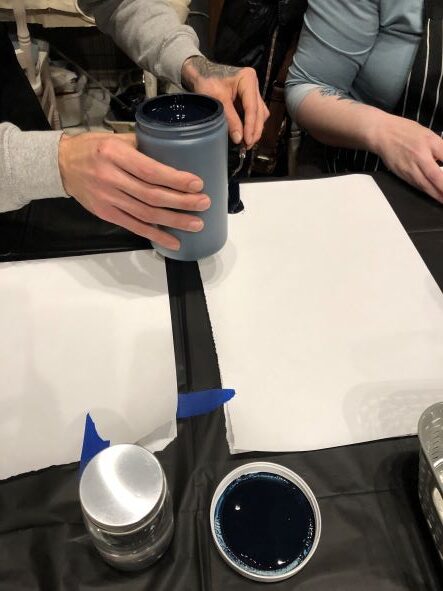
In our life there is a single color, as on an artist’s palette, which provides the meaning of life and art. It is the color of love.
Marc Chagall
Have you heard of Payne and why it is one of the most prolifically used colors in acrylics? What is your “go to” color when you are creating? Payne’s Gray has been around for hundreds of years and is still the anchor to an artist’s palette.
Guest Artist Colin Molaski is enthusiastic and loves acrylic paint like you might love, say, chocolate!
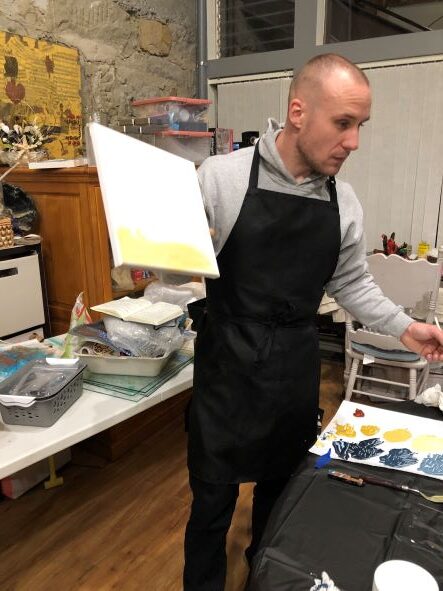
The Acrylic Abstractions class used a limited palette to create an unique, abstract masterpiece. To get started, Colin placed a soothing dollop of Titanium White, Payne’s Gray, Yellow Ochre, and Burnt Sienna onto a piece of butcher paper.
Yellow Ochre consists mostly of clay colored by iron oxides. It is a very saturated color that can be toned down with a touch of Payne’s Gray. Yellow Ochre’s main coloring component is the mineral limonite. It has been in use as a pigment since prehistoric times.
Burnt Sienna is a deep rich brown clay. Sienna contains a high degree of iron oxide with varying amounts of clay and quartz. In its natural state, it is yellowish brown and is called raw sienna. When heated, it becomes a reddish brown and is called burnt sienna.
For the lesson in abstractions, taking the Payne’s Gray and dividing into six shades by adding a little white, a little more white, and a little more white… then taking a little Yellow Ochre to create a cooler shade. A warmer shade. A darker shade. A lighter shade.
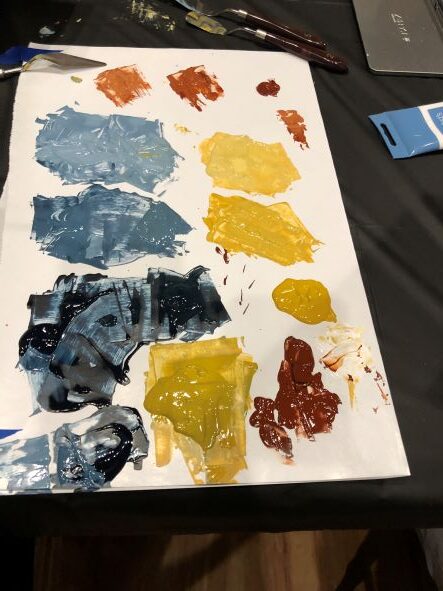
Painting with Payne’s Gray is a magical experience for acrylics painters. It appears almost black but is actually a dark blue-gray color which artists use to mix in place of black to develop the right shades for a wider color scheme.
When watercolor artist William Payne developed this mixture in the late 1700’s, he used a combination of Prussian Blue, Yellow Ochre, and Crimson Lake. As time went by the combination changed to what is now ultramarine or phthalocyanine and black.
Colin says, “Payne’s Gray isn’t boring, it interacts with other colors to give feelings. It gives a more exciting primary color”.
After creating this beautiful combination of colors to work with it’s time to create a composition!
Square, Triangle and Circle. Draw a triangle, a square and a circle with two of the shapes moving off the edge of the canvas. Turn the canvas 45 degrees. Pick a color off your palette and do it again. Turn it 45 degrees and repeat until the fourth time. This is a jumping off point for the next step. Scrape the palette knife across and let it smudge the lines.
Contemplate the outcome and focus on the lines you’ve now created. Now it’s time to paint! Loosely fill in and create shapes with various colors. Just let the painting develop based on how you feel. Let yourself go and create shapes, ask questions about how the various shapes make you feel and re-evaluate your process.
Keep the line alive. Let your eye decide what is working and what it is making you feel. Add in more color, letting the darks and mid-tones interact with one another. If two dark colors get together then punch in a little light color.
The technique Colin used was found to be “very forgiving”. If the artists didn’t like what was happening they could just add a little white, pull a color through, turn the painting to get a new perspective, or add a new line. To get over the fear and anxiety of “where do I start”, do a wash on the canvas and then let the painting guide you by training your eye on composition, color combinations and values, and what excites you visually. Find a palette combination that makes you feel curious. Ask questions about your painting.
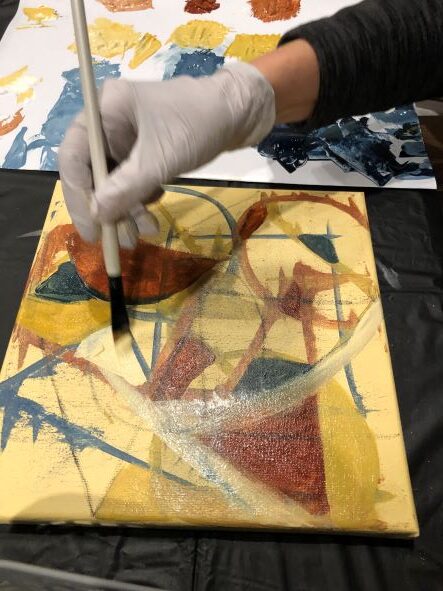
List of supplies:
- Acrylic Paint in Payne’s Gray, Yellow Ochre, Burnt Sienna, Titanium White
- Palette knives in various shapes
- Filbert brushes and flat brushes
- Butcher paper
- Water in a jar
- Paper towels
- Water based pencils
- Stabilo Pencils
The very first abstract acrylics class was a big hit! If you want to learn how to “let go” with your creativity, consider joining us for an upcoming abstraction!
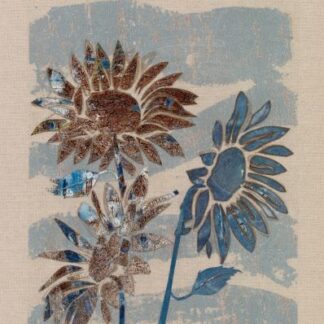
Beautiful description, Belinda! It sounds like it was a fantastic class. Knowing a little history about the colors you select adds a whole new depth of interest and wonder! Payne’s Gray is such a well-loved, go-to, pivotal color. Great palette, Colin!